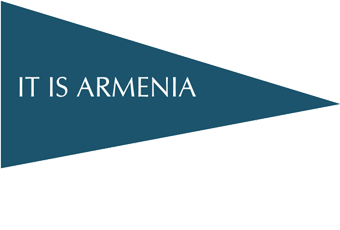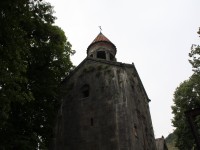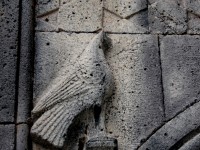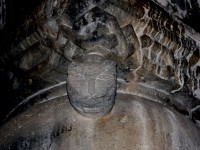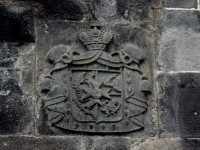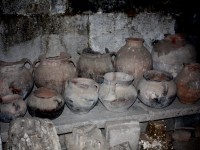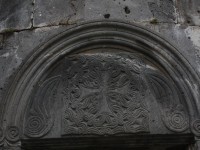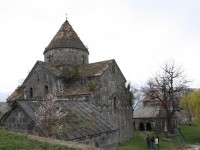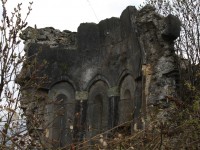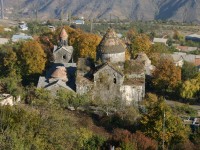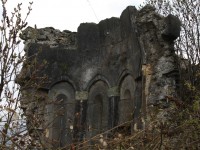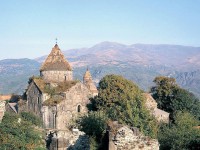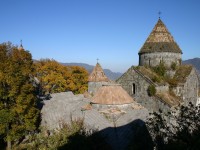Sanahin
The monastic complex of Sanain is located in the Sanain quarter of Alaverdi city, of Lori Marz (region), 170 km to the north of Yerevan. According to the one version of the etymology of Sanahin, the name is closely connected with the pitchers, as the word San in the ancient Armenian meant pitcher and Sanhain means an old pitcher. This interpretation is based on the etymology of the word roots of Acharyan that can not be considered to be right, because it is not a scientific and a historical interpretation. According to the folk legends, the monastery of Sanahin was named so because it was older than the monastery of Hakhpat, which was standing near and meaning of the name is interpreted as "This one is older than that one " (in Arm. Sa hin kan na). This interpretation is also vulnerable: in fact, in the pre-Christian Armenia, there was a temple dedicated to the pagan goddess Anahit in this place, hence the etymology of the name of the monastery is closely connected with the name Anahit, which means, "It's Anahit" (in Armenian. Sa Anahit e). The oldest building of the complex is the church of St. Holly Mother (St. Astvatsatsin). The building was built in the 930's, and was the initiator of the king Abas Bagratouni. As a monastic complex, Sanahin is mentioned only, after the Church of the Holy Christ the Savior (St. Amenaprkich) was built in 966. The church built the King Ashot III Voghormats (Merciful) and the Queen Khosrovanuysh for the longevity of their sons Gourgen and Smbat. This is evidenced by the sculptures of the two brothers depicted on the eastern wall of the Holy Christ the Savior (St. Amenaprkich) church. The date of building of the St. Grigor church is unknown. According to one version, the church was built by a daughter of the King David Anhoghin (Lackland), Princess Hranuysh in 1061. Nevertheless, as a result of Architectural expertise the church was attributed to the 980’s. At the end of the 10th century and in the early 11th century was built the Academy of Sanahin between the churches of St. Christ the Savior (St. Amenaprkich) and St. Holly Mother (St.. Astvatsatsin). It was called the Academy of Magistros as there was teaching Grigor Magistros, the most influential teacher and philosopher of those times. Graduate School Sanahin was glorified in the Middle Ages not only in Armenia but also out of its borders. One of the most important buildings of the monastic complex is the library. It has a circular building and is located near the church of St. Gregory, to the north-east of the church of St. Holly Mother (St. Astvatsatsin). It was built in 1063 by the order of the Queen Kyurikyan Hranoush. There were stored many manuscripts. Unfortunately, only 30 manuscripts survived and reached to our days. The gavit (narthex), which was built in 1184, is of a particular architectural value. In the construction works of the gavit (narthex), the daughters of the Lori’s king Kyurike III - Miriam Rusudan, Borin, and the aunt of the Queen Tamara, Rusudan attended. Each of them sponsored the structure of one of the four columns of the gavit (narthex). In 1211, the count Vache Vachutyan built the narthex Amenaprkich (Christ the Savior). At the entrance to the porch on the left side are placed khachkars (cross-stones) in memory to the son of Vache Vachutyana Kurd Vachutyana and his wife - Khorishah. The last major structure of the monastic complex is the bell tower. It is considered to be one of the most ancients in the Armenian architecture. The bell tower of Sanahin was built in the early 13th century. Further, in 1245 the bell tower was built of Haghpat. In the territory of the monastery of Sanahin are also located the grave of Kyurike I Kyurikyan, the mausoleum of Zakharyans, numerous khachkars (cross-stones), religious and secular buildings. The monastery of Sanahin is included in UNESCO World Heritage List.






